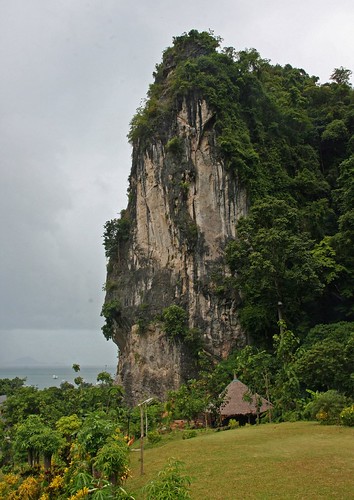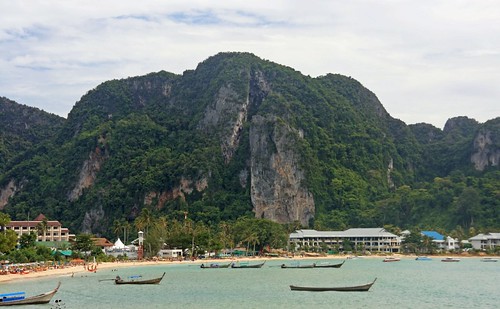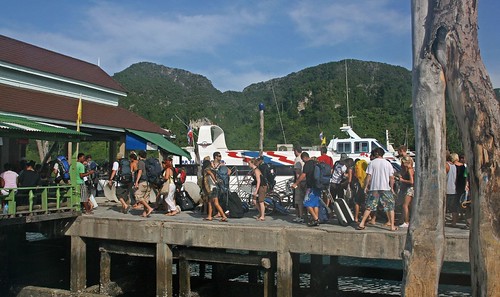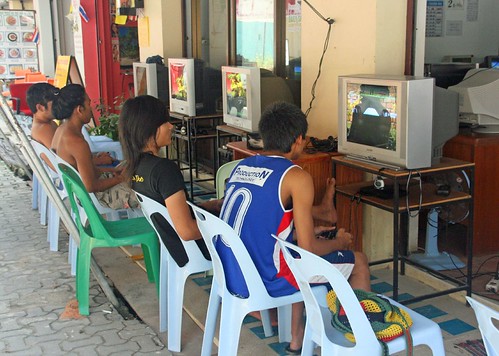The Andaman Express
I've been a slacker this past week about blogging. It's not that I don't want to blog, to fill you in on my whereabouts. It's just that I've been in a funk over my experience of late. Nothing bad has happened to me. I've just been disappointed over finding out that my expectations, however low they may have been, were not low enough. Bear with me as a complain for a while. It may not be pleasant, but I'm good at it.
When I last wrote, I was midway through a tour of the Andaman coast, a geographically spectacular region of Southern Thailand that attracts hoards of visitors throughout the year. My northward journey took me to the islands of Ko Lanta, Railay Beach and Ko Phi Phi, and finally through the tourist mecca of Phuket. These locations are all beautiful, with rugged coastline, white sand beaches, lush jungles and vast coral reefs. So what was my problem?

Railay Beach

Ko Phi Phi
Check out a map of Thailand and you'll see that the Andaman coast is a slender strip of land that connects the bulk of the country in the north to peninsular Malaysia to the south. Anyone that visits the area travels north to south or vice versa. As a first-time visitor to the region, I hit the popular spots (there's a reason they are popular, so why not check them out?), which meant I was part of a roving crowd shuffling from one beach to the next. That couple I met in Ko Lanta? They were in Railay too, and then again in Ko Phi Phi. Those British students at the next table in Railay? There they were huddled against the evening downpour at Ko Phi Phi. That couple I met over lunch in Railay? We had drinks at sunset in Ko Phi Phi and disovered that we were staying in adjacent bungalows. It's like we had all boarded a monorail and were getting on and off at the various stations along the way.

Backpacker Rush Hour, Ko Phi Phi
I mentioned in a post from Railay that I was looking forward to seeing Thailand. This feeling increased the longer I spent on the islands. Ko Lanta was quiet, with very few people in the resorts. At each stop on the journey north, the beaches were more crowded, the towns more frenetic.
I ended in Patong Beach in Phuket, the epicenter of sleaze. I'd heard so many horror stories about the place, about the sleaze and slime. I had to see it for myself. Bars, touts, hookers and scam artists don't add up to a pleasant time. Sleazy is too nice a word for Patong Beach. At least I found a friendly barber and got a nice haircut.
At Railay Beach and on Ko Phi Phi, I was surrounded by Eurpoeans and North Americans. Commercial areas offered an endlessly repeating loop of dive shops, travel agents clothing stores, minimarts, and restaurants and bars. Most of the restaurants served bland Thai food from English menus (I hunted down the places where the locals ate, and was generally happy with the food). At night the bars were filled with crowds of rowdy drinkers. Placards outside the bars advertised which movies they would screen each night ("Little Miss Sunshine" at 6, "Spider-Man 3" at 8). A few Internet cafes offered rows of televisions and libraries of Playstation 2 games, though I only saw young men (western and Thai) at the consoles, and they only played driving and soccer games. Everything I saw could have taken place at any college town in America or Europe.

Playstation Cafe, Ko Phi Phi
What makes this more interesting is that these are places that were hit hard by the Indian Ocean tsunami in December of 2004. But tourism is an important part of the Thai economy and rebuilding started immediately. A few shops displayed photographs of the destruction and aftermath, there were some DVDs for sale, and I saw one T-shirt with the words "Still Alive" printed on the front. But there were no memorials, nothing to educated visitors about the event. According to Wikipedia, on Ko Phi Phi 70% of the buildings were destroyed and 4,000 of the 10,000 people on the island were killed. Where are the memorials? There's a ton of money flowing into these places. Someone is missing a chance to do good.
The bottom line is probably simple: reminding people of killer waves is bad for business. And in southern Thailand, the tourism business is booming.
When I last wrote, I was midway through a tour of the Andaman coast, a geographically spectacular region of Southern Thailand that attracts hoards of visitors throughout the year. My northward journey took me to the islands of Ko Lanta, Railay Beach and Ko Phi Phi, and finally through the tourist mecca of Phuket. These locations are all beautiful, with rugged coastline, white sand beaches, lush jungles and vast coral reefs. So what was my problem?


Check out a map of Thailand and you'll see that the Andaman coast is a slender strip of land that connects the bulk of the country in the north to peninsular Malaysia to the south. Anyone that visits the area travels north to south or vice versa. As a first-time visitor to the region, I hit the popular spots (there's a reason they are popular, so why not check them out?), which meant I was part of a roving crowd shuffling from one beach to the next. That couple I met in Ko Lanta? They were in Railay too, and then again in Ko Phi Phi. Those British students at the next table in Railay? There they were huddled against the evening downpour at Ko Phi Phi. That couple I met over lunch in Railay? We had drinks at sunset in Ko Phi Phi and disovered that we were staying in adjacent bungalows. It's like we had all boarded a monorail and were getting on and off at the various stations along the way.

I mentioned in a post from Railay that I was looking forward to seeing Thailand. This feeling increased the longer I spent on the islands. Ko Lanta was quiet, with very few people in the resorts. At each stop on the journey north, the beaches were more crowded, the towns more frenetic.
I ended in Patong Beach in Phuket, the epicenter of sleaze. I'd heard so many horror stories about the place, about the sleaze and slime. I had to see it for myself. Bars, touts, hookers and scam artists don't add up to a pleasant time. Sleazy is too nice a word for Patong Beach. At least I found a friendly barber and got a nice haircut.
At Railay Beach and on Ko Phi Phi, I was surrounded by Eurpoeans and North Americans. Commercial areas offered an endlessly repeating loop of dive shops, travel agents clothing stores, minimarts, and restaurants and bars. Most of the restaurants served bland Thai food from English menus (I hunted down the places where the locals ate, and was generally happy with the food). At night the bars were filled with crowds of rowdy drinkers. Placards outside the bars advertised which movies they would screen each night ("Little Miss Sunshine" at 6, "Spider-Man 3" at 8). A few Internet cafes offered rows of televisions and libraries of Playstation 2 games, though I only saw young men (western and Thai) at the consoles, and they only played driving and soccer games. Everything I saw could have taken place at any college town in America or Europe.

What makes this more interesting is that these are places that were hit hard by the Indian Ocean tsunami in December of 2004. But tourism is an important part of the Thai economy and rebuilding started immediately. A few shops displayed photographs of the destruction and aftermath, there were some DVDs for sale, and I saw one T-shirt with the words "Still Alive" printed on the front. But there were no memorials, nothing to educated visitors about the event. According to Wikipedia, on Ko Phi Phi 70% of the buildings were destroyed and 4,000 of the 10,000 people on the island were killed. Where are the memorials? There's a ton of money flowing into these places. Someone is missing a chance to do good.
The bottom line is probably simple: reminding people of killer waves is bad for business. And in southern Thailand, the tourism business is booming.



0 Comments:
Post a Comment
<< Home